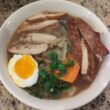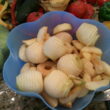This post may contain Amazon affiliate links. As an Amazon Associate I earn from qualifying purchases. Thank you for your support!
Cross-contamination has been a recent topic of discussion on my cousin Sally’s facebook page. She was officially diagnosed last week and has lots of questions about her new journey so when I saw this I thought I’d share. The following was taken from the Vitacost.com website under the heading of Celiac Disease Info.
Avoiding Cross-Contamination in Packaged Foods
By Rachel Begun, MS, RD
It happens to the best of us. We purchase a seemingly safe product only to find out later that it was contaminated with gluten.
The bad news is that we feel awful for days on end (except for those lucky few who are asymptomatic). The good news – yes, there’s a silver lining – is that feeling awful usually leads to a renewed dedication and sharpened awareness of the prevalence of gluten in certain foods.
For those of you who want to stay alert without first suffering, here are some tips for avoiding gluten in packaged foods:
Know the Signs
By signs I really mean symbols, the three third-party certification symbols. The Gluten Intolerance Group (GIG), Celiac Sprue Association (CSA) and National Foundation for Celiac Awareness, in partnership with Quality Assurance International (NFCA/QAI), have all created gluten-free labeling certification programs that enforce the strictest gluten-free manufacturing standards on food companies seeking to feature their certification seal on gluten-free food packages. Click on each link above to learn more about each program’s certification standards, become familiar with their seal, and see which food brands you can trust.
Get to Know the Reliable Manufacturers
Just because a food company doesn’t use a third-party certification seal doesn’t mean their products aren’t safe. As the gluten-free market matures, more manufacturers are working with experts to implement their own validation and testing protocols. You’re probably wondering how you can learn about these products without spending countless hours searching their websites, talking to their customer service departments and reviewing labels in the supermarket. While you may have to do some of the above, here are a few tips to save you time:
- Become a member of a celiac support group so you can get reliable information from people who have already done the research.
- Get to know a manager or registered dietitian at your local supermarket. Food companies educate these people about their gluten-free manufacturing practices knowing they will share this information with customers.
- Go to the gluten–free bloggers page of NFCA’s website. Companies typically share product information with the gluten-free blogging community knowing they will in turn share the information online.
Be a Smart Shopper
Packaged foods can be contaminated in the store. Be a smart shopper and avoid the following items:
- All bulk bin foods
- Foods that sit on shelves below gluten-containing flours, baking mixes and other products with crumbs or small particles that can leak through the packaging
- All bakery items made on site in the supermarket – unless they have a dedicated gluten-free baking facility
- Seemingly gluten-free prepared foods in the deli case or salad bar that can become contaminated from neighboring options that contain gluten
However, the best advice for avoiding gluten contamination in packaged foods is to focus the diet on naturally gluten-free foods, including fresh fruits and vegetables, lean meats, poultry and fish, low-fat dairy, legumes, nuts and seeds. This is not only good advice for eating safely, but also for eating healthfully.
National Foundation for Celiac Awareness
The National Foundation for Celiac Awareness offers Vitacost.com website visitors weekly recipes and blogs about living the gluten-free lifestyle. For more updates from NFCA about celiac disease and gluten-free living, go to www.CeliacCentral.org/subscribe.
Aug 17, 2012 2 comments
Amazon and the Amazon logo are trademarks of Amazon.com, Inc, or its affiliates.







